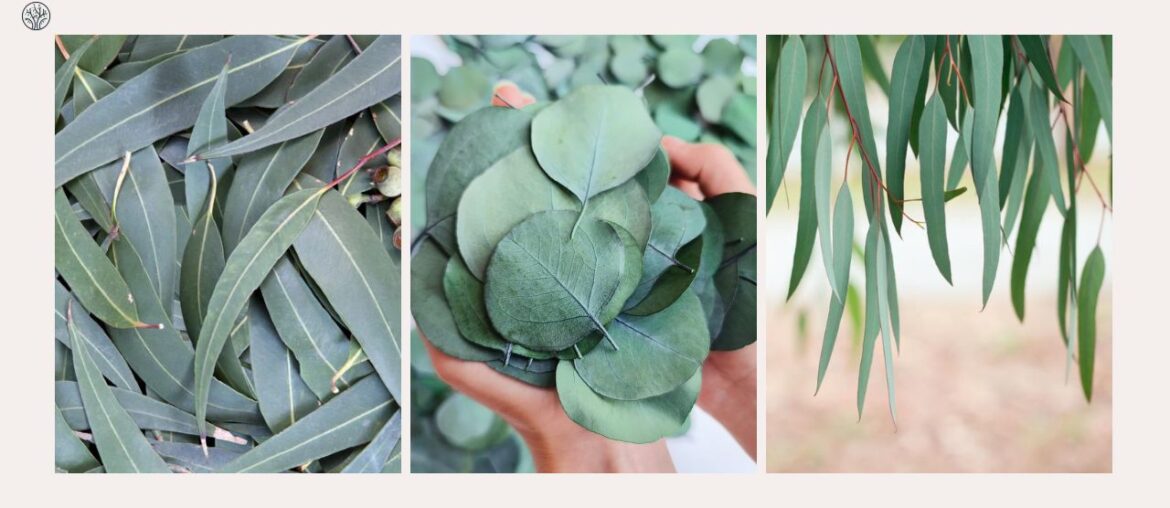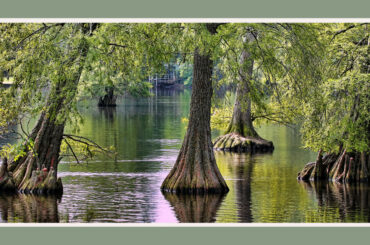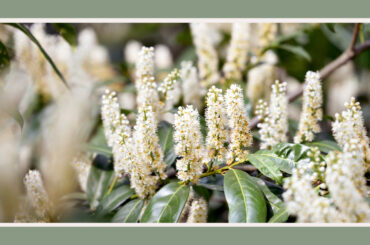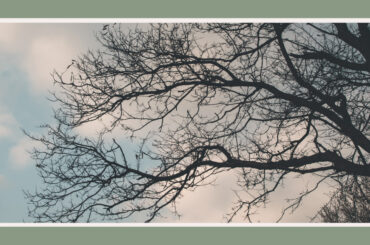Eucalyptus trees are among the most diverse and versatile plants in the world. One of the most noticeable differences among these trees is the shape of their leaves. There are different types of eucalyptus leaves: long and narrow, round, oval, heart-shaped, or even sickle-shaped.
In this article, we will explore some of the most common eucalyptus trees based on their leaf shape and other features. We will also review their practical uses and benefits for humans and the environment.
But before diving deeper, let’s start with the basics: Eucalyptus trees belong to the genus Eucalyptus, which contains over 700 species of evergreen trees and shrubs native to Australia, New Guinea, Indonesia, and nearby islands.
Eucalyptus trees are easy to recognize, with a minty or camphor-like smell and peeling bark that reveals different colors and textures underneath. They have flowers that consist of a cup-like base and numerous stamens that attract pollinators.
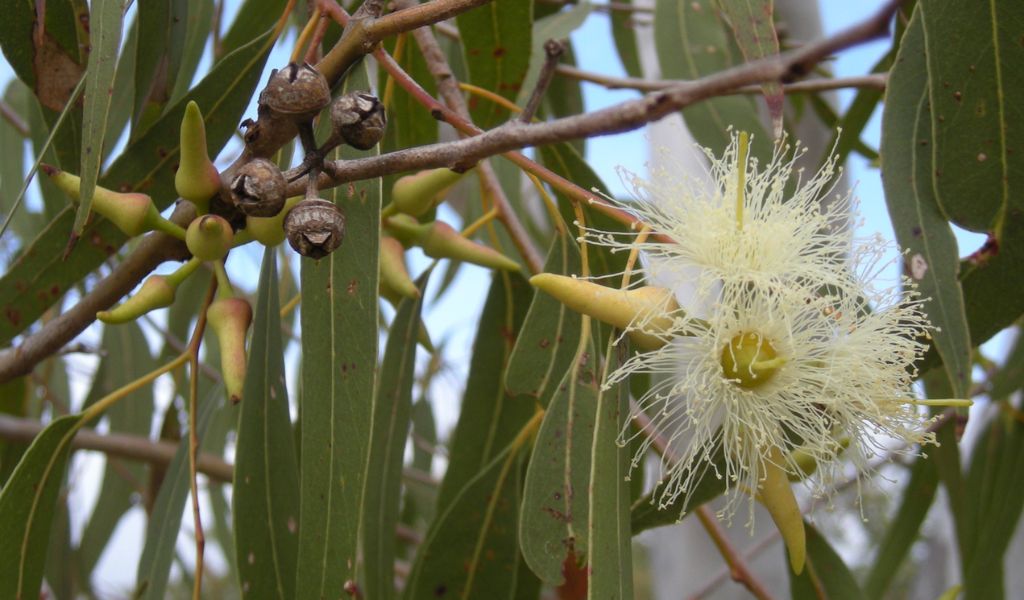
Also, they have fruits that are woody capsules containing tiny seeds.
What’s more? As mentioned in our last articles, eucalyptus sap is poisonous and flammable.
What sets eucalyptus trees apart is they can change the shape of their leaves during the mature process. These shapes help identify the type of eucalyptus tree, as well as its potential uses.
Ornamental And Landscaping Eucalyptus
Many eucalyptus trees are grown for their ornamental value, either as landscape plants or as cut flowers and foliage. These trees have attractive leaves that vary in color, texture, and arrangement. They also have showy flowers that range from white to pink to red to yellow. Some of these eucalyptus trees are:
Silver Dollar Eucalyptus
Silver dollar Eucalyptus scientific name is Eucalyptus cinerea. This type of eucalyptus tree has round, silvery-green leaves about the size of a silver dollar coin. The leaves stay in opposite pairs along the stems.
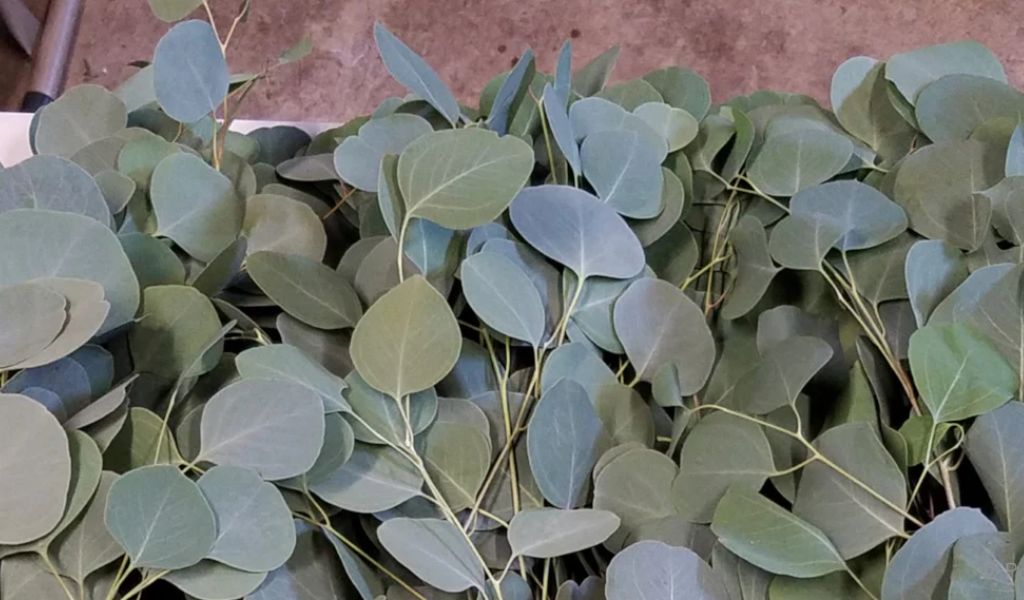
This silver dollar eucalyptus is native to Australia but widely appears in other countries as an ornamental plant. The flowers are white or cream-colored and have a sweet fragrance. It is also popular as cut foliage for floral arrangements.
Seeded Eucalyptus
Seeded Eucalyptus is a type of greenery known for its textured appearance, making it a popular choice for floral arrangements, especially in wedding settings. These trees have oval to heart-shaped gray-green leaves. The leaves grow alternately along the stems.
Besides, the flowers are small and white and are followed by woody fruits that contain numerous seeds. The seeded eucalyptus is native to Australia but appears in other regions for its decorative fruits and foliage.
Gumdrop Eucalyptus
The gumdrop eucalyptus tree features blue-green, round to oval leaves that spiral around its stems. It blooms with vibrant red or pink flowers with a bell-shaped base and long stamens.
While native to Australia, this eucalyptus variety is also grown in other nations as an ornamental plant. Additionally, it serves as a nectar source for honey production.
True, Baby Blue Or Spiral Eucalyptus
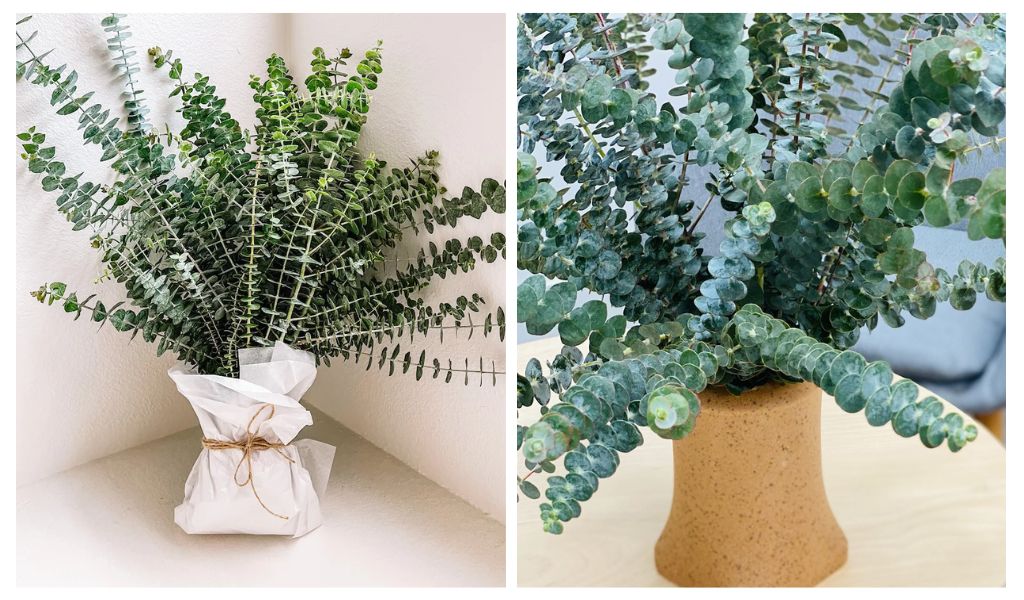
The baby blue eucalyptus tree has oval, blue-gray leaves that spiral around the stems, lending them a distinct, twisted look. It produces white or cream-colored flowers with a cup-shaped base and long stamens. While its native home is in Australia, this eucalyptus variant also appears in other areas for its fragrant leaves and blossoms.
Parvifolia Eucalyptus
This eucalyptus tree type has narrow to lance-shaped leaves that are green or gray-green. These leaves grow alternately along the stems. The tree graces us with delicate white or cream-colored flowers with a cup-shaped base and long stamens.
This unique tree contributes to the rich biodiversity of plant life, adding a touch of elegance to its native and cultivated landscapes.
Feather Eucalyptus
The Feather Eucalyptus is a unique eucalyptus tree variety with long and narrow leaves that come in shades of green or gray-green. What sets it apart is that its leaves expand in opposite pairs along the stems, creating an eye-catching symmetrical pattern.
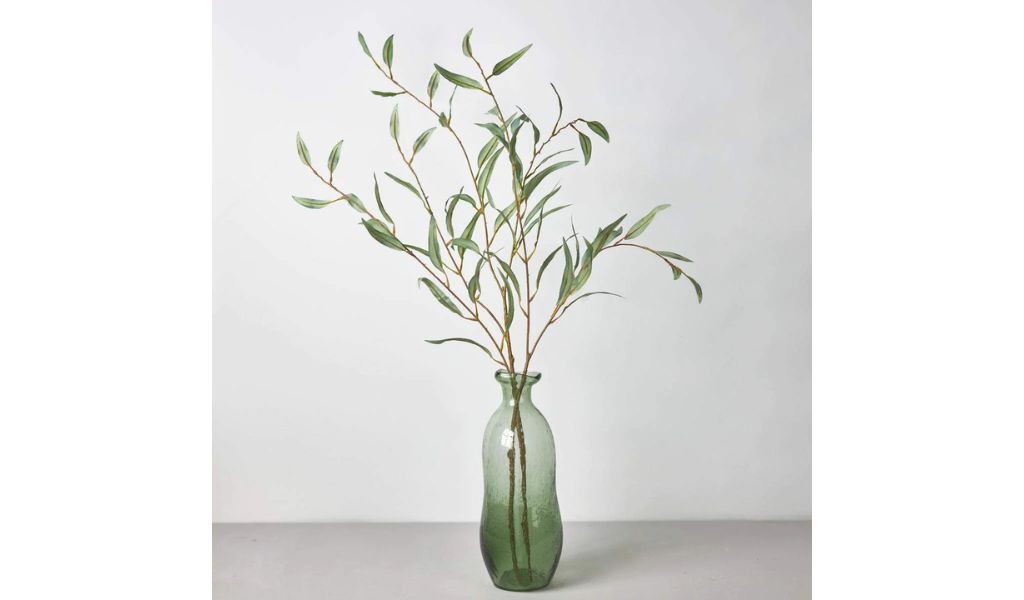
When it blooms, this eucalyptus shows delicate white or cream-colored flowers, each with a cup-shaped base and long stamens, lending an elegant touch to its appearance.
The Feather Eucalyptus’ impressive foliage and charming flowers make it a sought-after ornamental plant, enhancing the beauty of landscapes and gardens where it is grown.
Willow Eucalyptus
Willow Eucalyptus, scientifically known as Eucalyptus Babylonia, is a unique species renowned for its graceful, willow-like branches and slender leaves. The most striking feature of this variety is its long, narrow, and drooping leaves. These leaves have a distinct willow-like appearance, hence the name.
The leaves of Willow Eucalyptus are typically bluish-green or grayish-green, giving an elegant and calming aesthetic. Meanwhile, its bark is smooth and has a pale, creamy color, which can offer an exciting contrast to its green leaves.
Like many eucalyptus species, Willow Eucalyptus produces small, inconspicuous flowers. These flowers are typically white or cream and are grouped in clusters.
Rainbow Gum – Eucalyptus Deglupta
The Rainbow Gum is a captivating and vibrant eucalyptus tree species known for its stunning multicolored bark. The bark peels away in strips, revealing various colors, including blue, purple, orange, and maroon. As the tree matures, these colors change, creating a living work of art that inspired the common name “Rainbow Gum.”
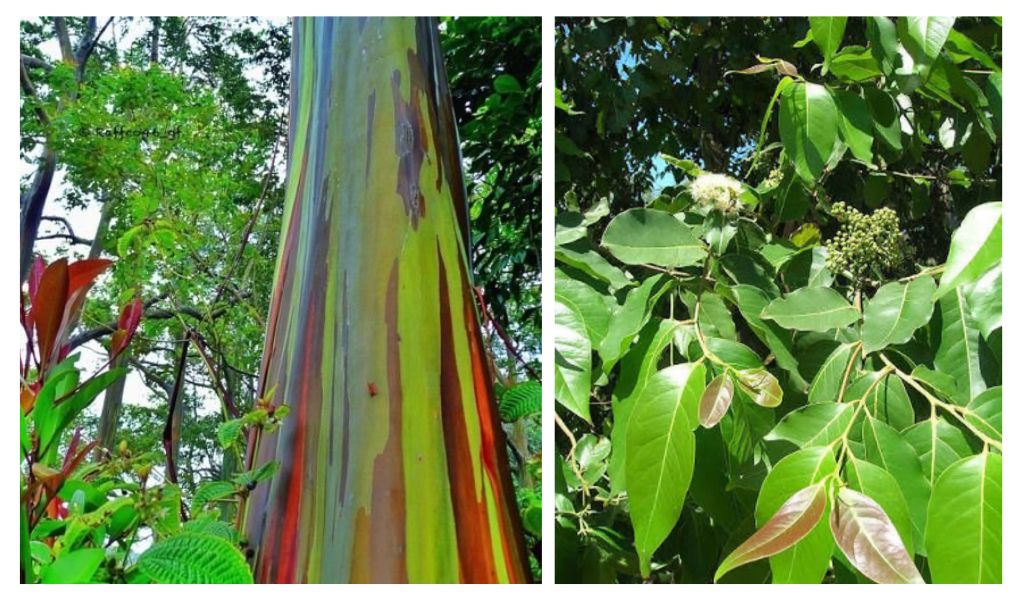
The leaves of Eucalyptus deglupta are long and lance-shaped, with a glossy green appearance. These species are native to parts of Southeast Asia, particularly in regions with a tropical or subtropical climate. It thrives in areas with high rainfall.
Due to habitat loss and deforestation in some regions, the conservation of Eucalyptus deglupta has become essential to protect its unique and colorful features.
Spinning Gum – Eucalyptus Perriniana
One of the most distinguishing features of the Spinning Gum is its foliage. The tree is known for its rounded, bluish-green leaves arranged in pairs along the branches. The leaves give the tree a distinctive appearance, and their shape is reminiscent of coins.
The bark of the Spinning Gum is typically smooth and can vary in color, ranging from white to gray or blue-gray. The bark provides an interesting contrast to the tree’s leaves.
Like other eucalyptus species, the Spinning Gum produces small, inconspicuous flowers with white or creamy tones. These flowers are often grouped in clusters and attract pollinators.
Medicinal And Essential Oils Eucalyptus
Some eucalyptus trees are famous for their medicinal and essential oil properties. These types of eucalyptus leaves often contain high concentrations of eucalyptol, which is a compound that has antiseptic, anti-inflammatory, decongestant, and expectorant effects.
Southern Blue Gum – Eucalyptus Globulus
The Southern Blue Gum, scientifically known as Eucalyptus globulus, features oval to lance-shaped leaves with a blue-green hue. These leaves come in alternately along the branches. Also, it has delicate white or cream-colored flowers with a cup-shaped base and long stamens.
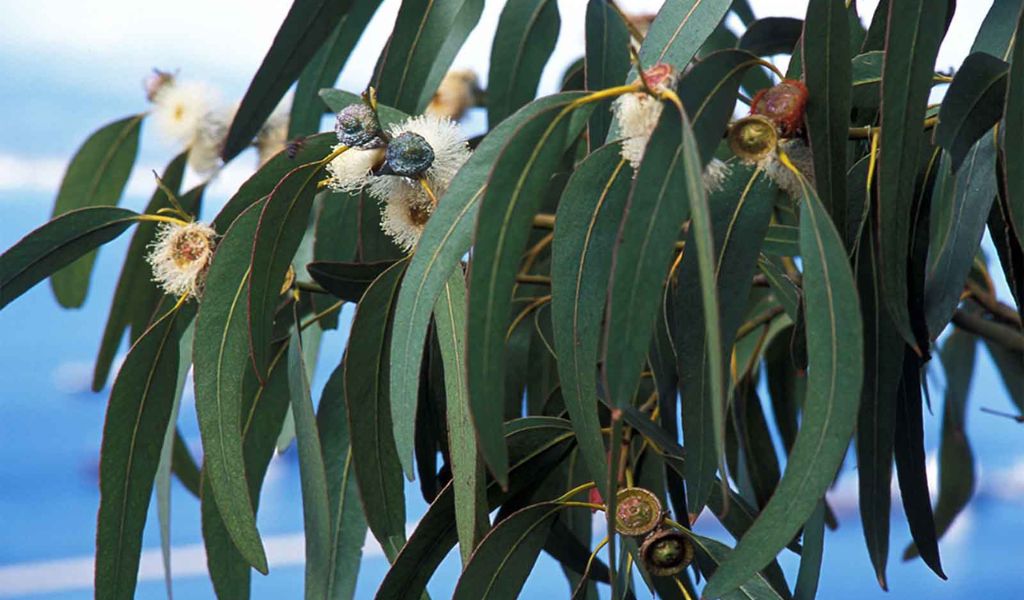
Native to Australia, the Southern Blue Gum is also vastly grown in other regions, primarily to produce its essential oil. It is among the most commonly used sources of eucalyptus oil, which holds a significant place in natural medicine.
Blue-Leaved Mallee – Eucalyptus Polybractea
The Blue-Leaved Mallee stands out with its striking blue-gray to silver-blue leaves. These leaves are linear in shape and give the tree its remarkable appearance.
The tree’s bark is typically rough and fibrous, varying in color from gray to brown. The combination of its unique leaves and textured bark makes it an eye-catching addition to the landscape.
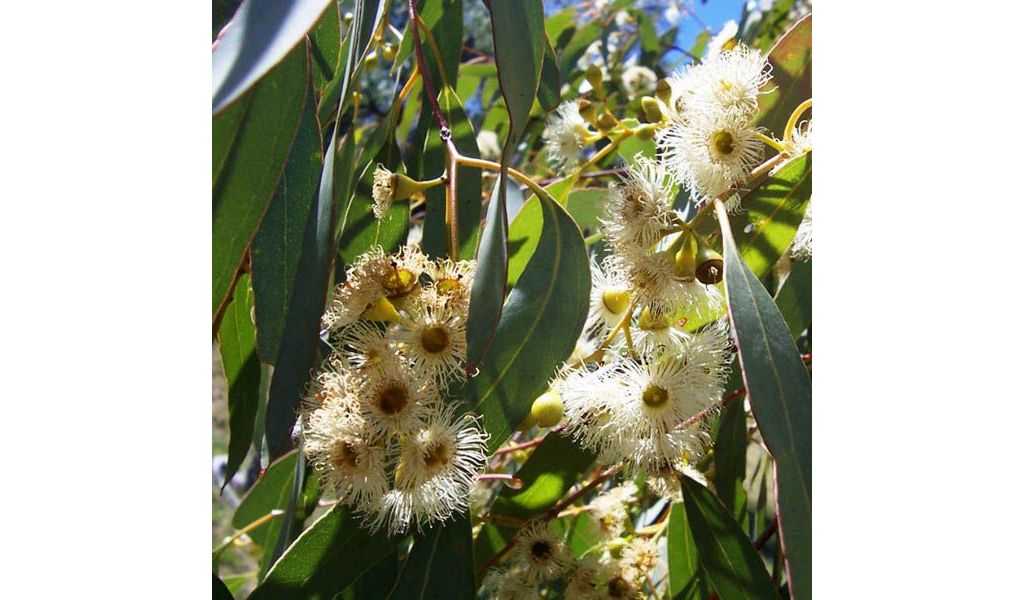
These trees have multi-stemmed growth habit, with several slender trunks branching out from a joint base. It creates a bushy and compact appearance.
Many value this eucalyptus species for its essential oil, a product of its leaves. The oil is potent, refreshing aroma and is widely used in aromatherapy and medicinal applications.
White Peppermint – Eucalyptus pulchella
White Peppermint is a charming and visually appealing eucalyptus tree species native to parts of Western Australia. It has small, lance-shaped leaves with a pleasant silvery-green to gray appearance. The leaves give the tree a distinctive and attractive look.
The tree’s bark is typically smooth and has a white, gray, or pale cream color. This smooth bark adds to the tree’s visual appeal.
White Peppermint generally grows as a small to medium-sized tree, with a compact and upright growth habit. It is well-suited for ornamental use in gardens and landscapes. While not as well-known for its essential oil as some other eucalyptus species, some still choose White Peppermint oil for its refreshing scent.
Willow-Leafed Peppermint – Eucalyptus Nicholii
What is unique about Willow-Leafed Peppermint is its slender, lance-shaped leaves with a fresh and silvery-blue to gray-green color. The leaves create a willow-like appearance, which lends the tree its common name.
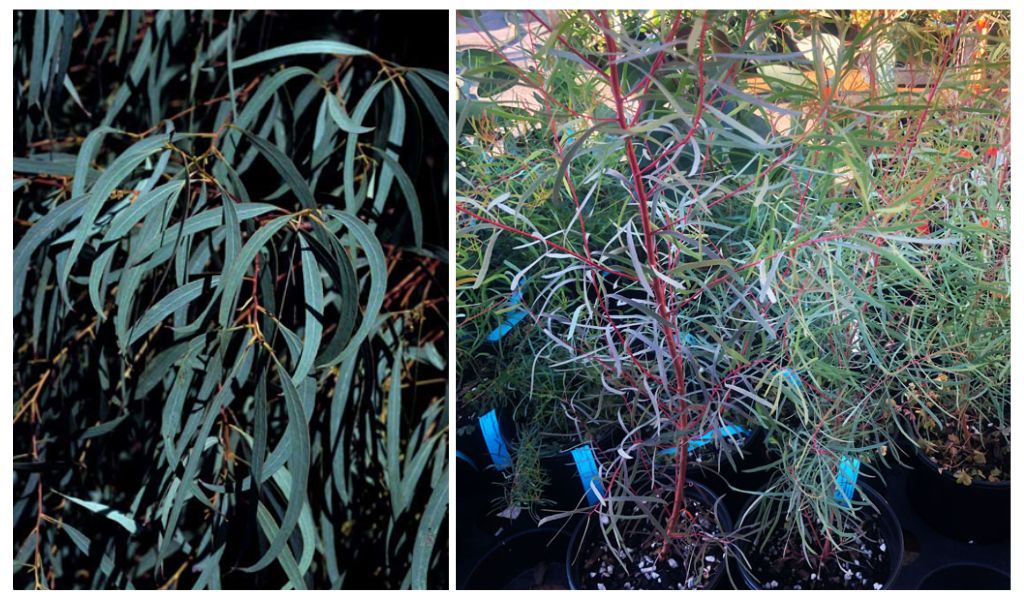
Eucalyptus nicholii often grows as a small to medium-sized tree, featuring a graceful and weeping growth habit. Its branches droop elegantly, creating an attractive and ornamental effect.
The tree produces essential oil in aromatherapy with an invigorating and refreshing aroma. We mainly use it in diffusers, essential oil blends, and massage oils.
Timber And Construction Eucalyptus
Finally, some eucalyptus trees are famous for their timber and construction value. These types of eucalyptus trees have wood that is strong, durable, and resistant to termites and fungi. They are suitable for various purposes, such as furniture, flooring, paper, and firewood. Some of them are:
Red Gum – Eucalyptus Camaldulensis
Eucalyptus camaldulensis, commonly known as Red Gum, is a notable and widely recognized eucalyptus tree species native to Australia. It has lance-shaped leaves that are typically dark green.
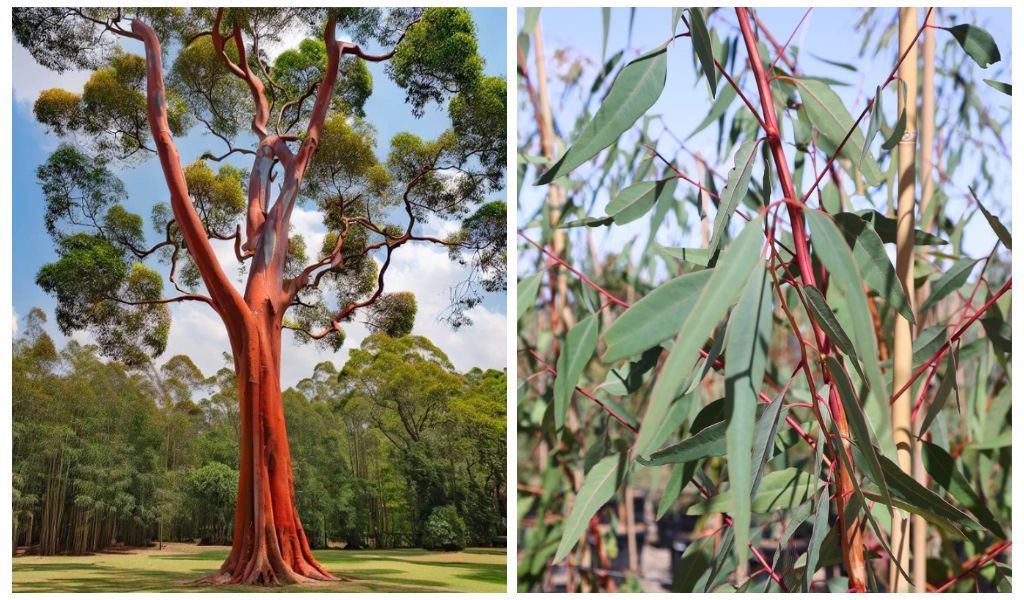
However, the most distinctive feature is its bark, which sheds in long strips, revealing smooth, pink to reddish-brown, and often mottled or patchy bark underneath. That’s also where the name “Red Gum” comes from.
Red Gum can grow into a tall and stately tree with a straight trunk and a dense canopy of foliage. It is well-suited for ornamental use and provides ample shade and shelter.
Meanwhile, people highly value the wood of Red Gum for its durability and strength. People use it for various purposes, including construction, furniture, and flooring. The timber has a distinct reddish hue, adding to its appeal.
Mountain Gum – Eucalyptus Dalrympleana
Mountain Gum, a graceful tree species native to eastern Australia, has lance-shaped leaves with a glossy green appearance. Its leaves are typically long and slender, creating fine-textured foliage.
Mountain Gum has a smooth bark, which features a powdery white to light gray surface, which can peel away in ribbons. These trees typically grow as tall and slender trees with an upright and relatively open top. They can reach substantial heights, making them an attractive choice for decorative landscaping.
Omeo Gum/Big O – Eucalyptus Neglecta
Eucalyptus neglecta, commonly known as Omeo Gum or Big O, is a tree species native to southeastern Australia. It includes broad, lance-shaped leaves with a fresh, silvery-blue to gray-green color. These leaves are relatively large compared to many other types of eucalyptus leaves.
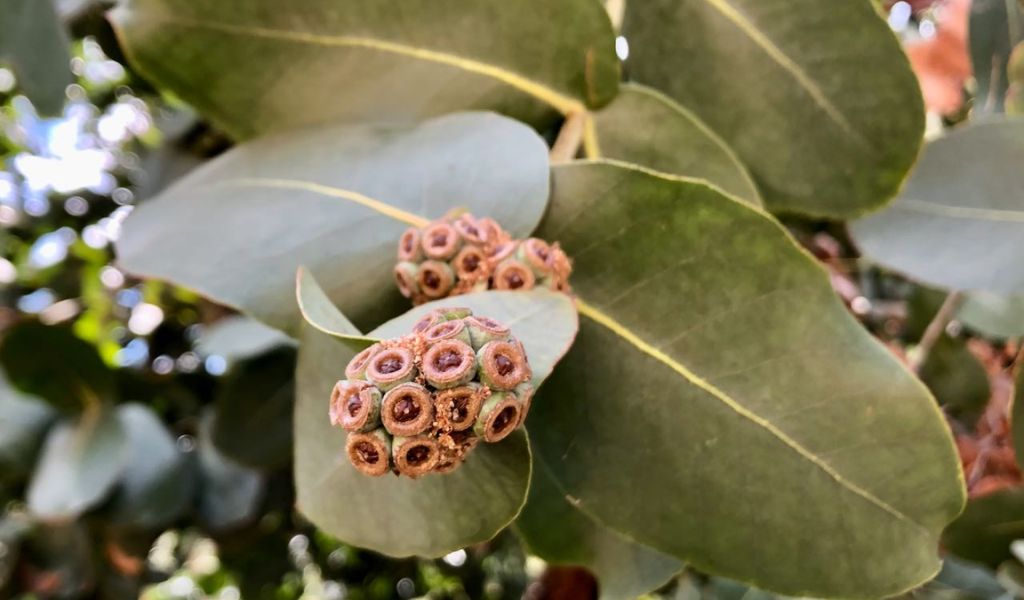
Overall, eucalyptus neglecta often grows as a medium-sized tree with a dense and symmetrical canopy. Its growth habit is relatively compact, making it a popular choice for ornamental use in gardens and landscapes. Also, the wood of Omeo Gum is occasionally used as a source of firewood, as it burns well and produces a hot flame.
Candlebark – Eucalyptus Rubida
This type of eucalyptus tree has narrow to lance-shaped leaves that are green or gray-green. Its leaves grow alternately along the stems. Like other eucalyptus tree species, its flowers are white or cream-colored and have a cup-shaped base and long stamens.
The Candlebark is native to Australia but is also grown in other regions for its timber production. It produces pale brown wood with a fine texture and straight grain, ideal for making furniture, flooring, paneling, joinery, and pulp.
Brown Mallet – Eucalyptus Astringents
Brown Mallet is primarily growing in the southwestern region of Australia. This type of eucalyptus tree has narrow to lance-shaped leaves that are green or gray-green. The leaves grow alternately along the stems.
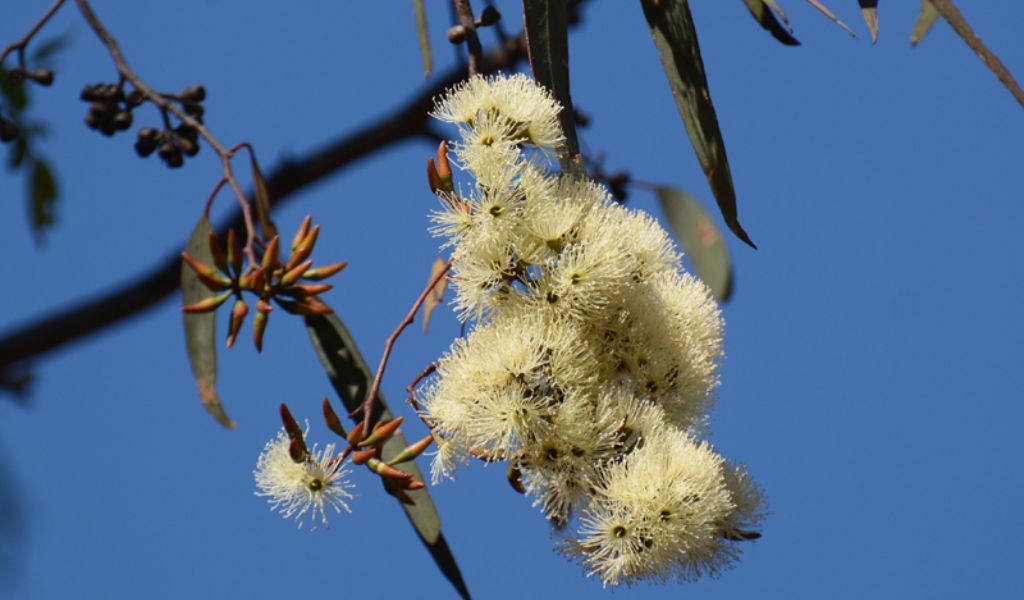
Brown Mallet trees can reach heights of approximately 50 feet, with occasional individuals growing up to 70 feet. It makes them a substantial presence in the landscape. People value the timber from this tree for its quality and suitability for various construction purposes.
See more: Leaves of dogwood tree.
Uses Of Eucalyptus
As you can see, eucalyptus trees have many uses and benefits for humans and the environment. Their most common benefits include:
Essential Oil
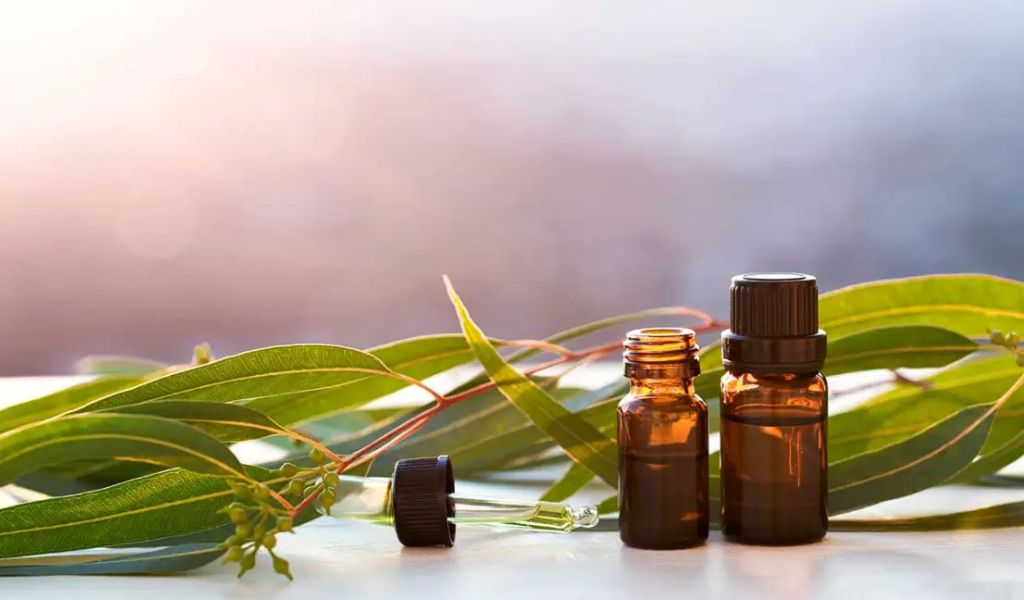
Eucalyptus oil contains various compounds that have medicinal and therapeutic properties, such as eucalyptol, cineole, pinene, limonene, terpinene, phellandrene, cymene, and others. We use eucalyptus oil for countless benefits:
- Treat respiratory infections, coughs, colds, asthma, bronchitis, sinusitis, sore throats, and other conditions by inhaling the vapor or applying it topically.
- Relieve pain, inflammation, muscle spasms, headaches, arthritis, rheumatism, neuralgia, and more by massaging it into the affected area or adding it to a bath.
- Heal wounds, burns, cuts, insect bites, skin infections, acne, eczema, psoriasis, etc.
- Repel insects by spraying it or applying it to the skin or clothing.
- Enhance mood, alertness, concentration, memory, and mental clarity by diffusing or inhaling it.
- Clean and disinfect surfaces, floors, toilets, sinks, and other areas by adding it to water or a cleaning solution.
- Deodorize and freshen the air, clothes, shoes, and other items by spraying it or adding it to a dryer sheet or a cotton ball.
Fuel as Firewood
Besides being an effective essential oil, eucalyptus is a good fuel source as firewood. Eucalyptus wood has a high calorific value, producing a lot of heat when burned. It also burns cleanly and efficiently, leaving little ash and smoke.
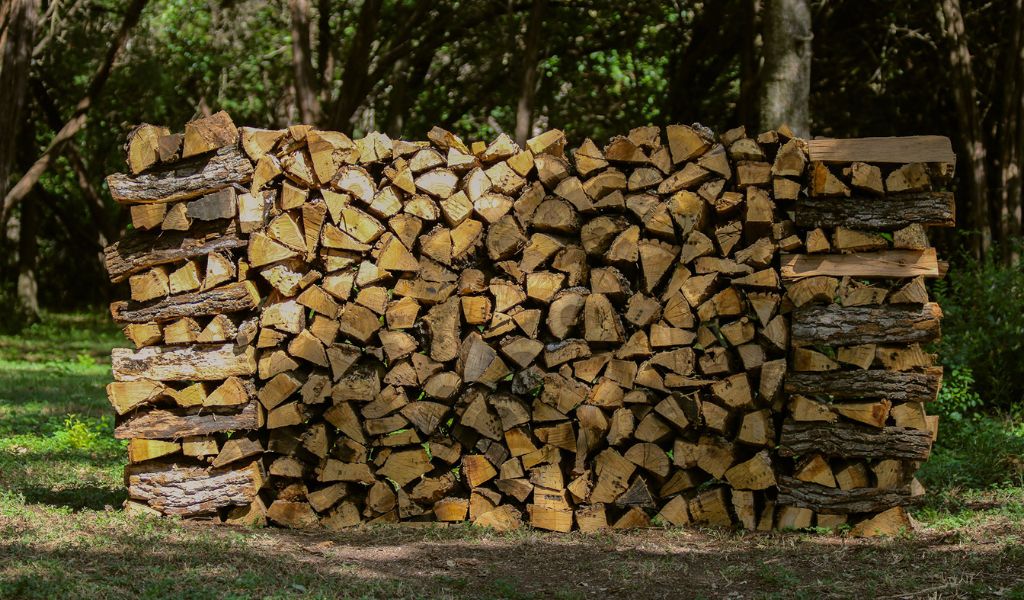
Many use eucalyptus wood for heating homes and water, cooking food, and generating electricity.
The fact that 65% of the people in MDPI’s survey are eager to use eucalyptus firewood suggests that more and more individuals see eucalyptus as an excellent choice for keeping warm.
Windbreaks
Eucalyptus trees can be windbreaks to protect crops, livestock, buildings, and soil from solid winds. They reduce wind speed, erosion, evaporation, and damage caused by wind. Another benefit is the improvement of microclimate, biodiversity, and aesthetics.
There are many reasons to use eucalyptus trees as windbreaks:
- They grow fast and tall, reaching up to 330 feet (100 meters).
- The trees have dense and evergreen foliage that provides year-round protection.
- These species have solid and flexible stems that can withstand high winds.
- Eucalyptus trees have deep and extensive root systems that stabilize the soil and prevent erosion.
Eucalyptus and the Monarch Butterfly
Eucalyptus trees have a special relationship with the monarch butterfly (Danaus plexippus), a migratory insect that travels thousands of miles from North America to Mexico yearly.
During the winter months, the monarch butterfly needs a place to roost and rest in large groups. Eucalyptus trees provide an ideal habitat for the monarch butterfly because they have large and broad leaves that offer shelter from rain and cold.
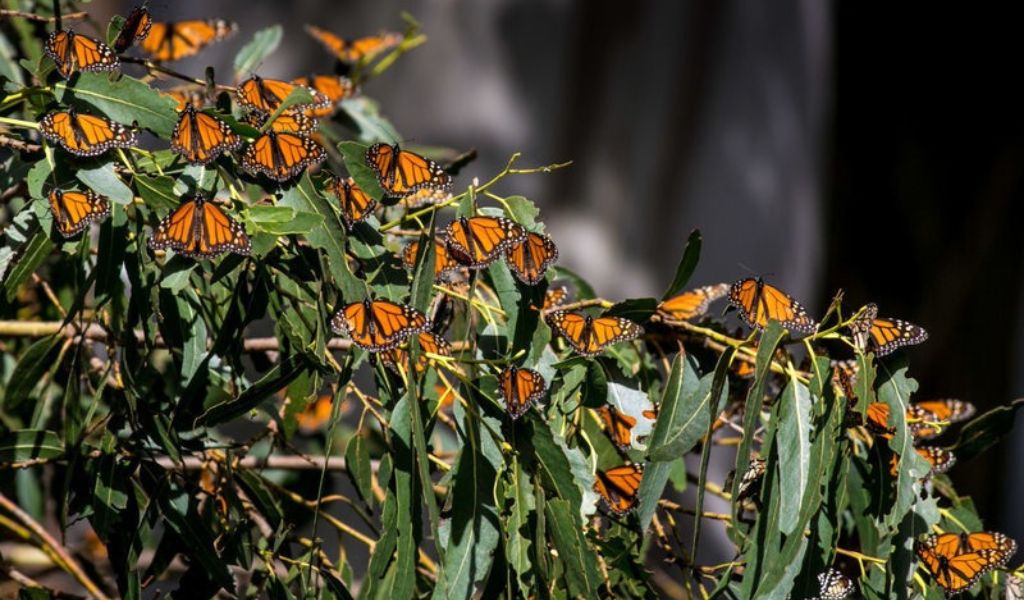
Eucalyptus trees didn’t initially grow in North America; people brought them over as decorative plants during the late 1800s. In California, they’ve formed large groves that many monarch butterflies visit each winter.
Some think of eucalyptus trees as invasive because they can take over and push out the local plants and animals. But, on the other hand, they’re essential for the monarch butterflies that use them as a home.
FAQs
What type of leaf is eucalyptus?
Fully grown Eucalyptus plants typically have long, narrow leaves that are attached to the stem by a stalk. These leaves grow one at a time, and they have a shiny green appearance. Meanwhile, young Eucalyptus plants often have leaves that come in pairs, don’t have a stalk, and have a bluish-gray color.
How do I identify eucalyptus leaves?
You can identify Eucalyptus leaves by their aromatic smell (minty or camphor-like), oil glands (visible as tiny dots on the surface), venation (parallel or slightly curved), or margin (entire or slightly serrated).
What is the scientific name of eucalyptus?
The scientific name of eucalyptus is Eucalyptus L’Heritier ex Aiton. The genus name Eucalyptus comes from the Greek words eu (meaning well) and kalypto (meaning covered), referring to the operculum (cap) that covers the flower buds. The species’ name varies depending on the type of eucalyptus tree.
Which eucalyptus type is most commonly used by florists?
The most common type of eucalyptus florists use is the silver dollar eucalyptus. It has round, silvery-green leaves about the size of a silver dollar coin. This type of eucalyptus leaf is famous as a cut foliage for floral arrangements because of its attractive color, shape, and aroma.
Final Thoughts
Different types of eucalyptus leaves are beautiful plants with different varieties, uses, and benefits. They are widely grown and appreciated for their ornamental, medicinal, and industrial value.
Whether you’re admiring their graceful appearance or benefiting from their applications, Eucalyptus trees stand as a testament to the remarkable diversity and utility of the plant kingdom.

